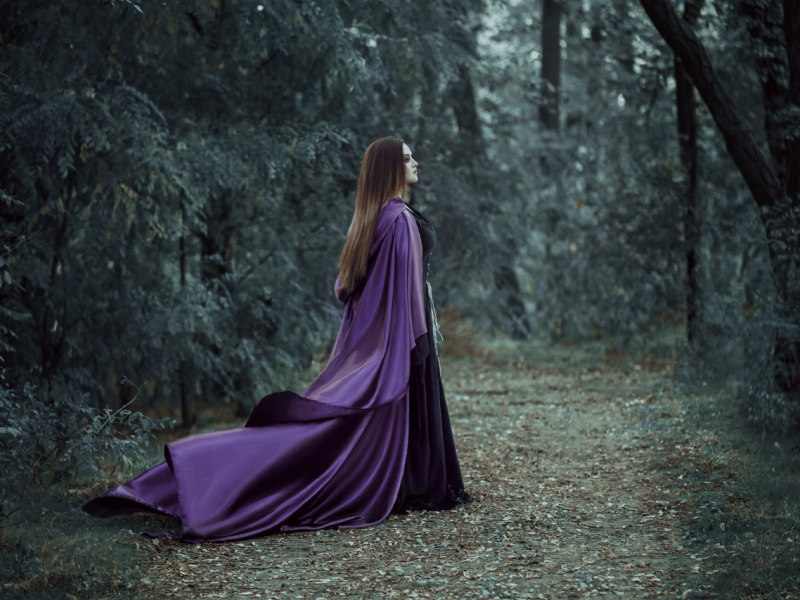Korrigan
The most common female fairies in the Breton tradition were the korrigans that resided in the woods, especially at Broceliande and often near a stream, spring or fountain. She was a fairy that sought a mortal lover.
The korrigan seemed to be the Breton version of the banshee. The korrigan was probably a pagan druidess originally. She was equated with gwragedd annwn – the Welsh fairies of the lake and streams.
She tried to seduce mortals who would drink from her water, and she would lure him to sleep with her. If the man refused her advances or seduction, she would angrily curse him to a certain doom. This was what happened to the Seigneur of Nann.
The Seigneur was married to a woman whom he loved. One day, his wife asked for some May-blossoms from the forest. The Seigneur rode out but during his ride, he became thirsty and drank the water from a fountain. There, the Seigneur encountered the korrigan who demanded that he sleep with her. But the Seigneur angrily refused because he was faithful to his wife and rode away after hearing that he would die in three days. The moment the Seigneur rode back to his castle, he went immediately to the church, instead of back to his wife. The priest, his mother and other people kept the secret of his fate from his wife. Three days later, the Seigneur's mother finally told her daughter-in-law the truth. The wife died of a broken heart and was buried beside the Seigneur.
In Breton folklore, she was the most likely suspect in the abduction of mortal infants. As foster-mother of a baby, she would raise it as if the child were her own.
The korrigan has been compared to several figures in mythology and legend. These were most likely antecedents of the korrigan. One of them was the Welsh goddess Ceridwen (or Keridwen). She was wife of the giant Tegid Foel and resided at Lake Tegid.
There were two other notable antecedents to the korrigan within the Arthurian legends, and they resided either near a fountain or within the lake itself at Broceliande. They were the Countess or Lady of the Fountain, and the Lady of the Lake.
The korrigan was sort of like the Lady of the Fountain in the legend of the Welsh Owain or French Yvain. Though the Welsh version in the Mabinogion doesn't disclose the name of the forest or the fountain, Chretien de Troyes located the fountain in the forest of Broceliande.
Owain or Yvain actually married the Lady of the Fountain after slaying her husband. Though the hero wasn't doomed to die, he lost his wits because a damsel removed the wedding ring from his finger, because he forgot to return to his wife after one year's sojourn in King Arthur's court. He roamed the forest as a naked wild man. Eventually his wits were restored and he was reunited with his wife, after many heroic adventures.
The Lady of the Fountain didn't seem to have any special power like a korrigan, but she was a lady of an otherworldly castle and her fountain had strange powers over the weather. See Yvain and the Lady of the Fountain.
The Lady of the Lake was known by several names - Niniane, Viviane, Vivian, Vivien, Eviene and Nimue. Whatever her original name was, by the time of Chretien de Troyes (died in c. 1185), she was seen as more of a fairy than a goddess.
The Lady of the Lake exhibited the closest characteristics to the korrigan, but the Lady was more benevolent than the korrigans. The Lady of the Lake was responsible for giving the sword Excalibur to King Arthur (see Legend of Excalibur, New Sword). She abducted the infant Lancelot from Queen Elaine (or Helen) of Banoic and raised the infant to manhood. She was Lancelot's tutor. (See Lancelot.)
But most interesting is the Lady of the Lake's connection with Merlin, Arthur's wizard and counsellor. Merlin was infatuated with the lovely Lady of the Lake. Though Merlin was gifted with divination, he was helpless to prevent his doom. He taught her all of his skills in magic in the hope of winning her love, which included hiding her palace and domain either under the lake or in an illusionary lake. But the Lady of the Lake had no intention of sleeping with the wizard, and she used the last magic he had taught her to confine or entomb Merlin in or under the large stone. (See Legend of Excalibur, Death of Merlin.)
Both the Lady of the Fountain and the Lady of the Lake were thought to be originally goddesses of the water. And due to the connection of these ladies to a body of water within the forest of Broceliande, there is a striking resemblance to the korrigans.
Related Information
Name
Korrigan, Corrigan.
Ozegan, Ozeganned.
Culture
Breton.
Type
solitary.
Sources
Legends and Romances of Brittany was written by Lewis Spence (1917).
Related Articles
By Jimmy Joe




